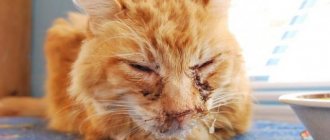Cat fleas are small brown insects that feed on the blood of animals and humans.
Many people, wondering whether cat fleas are transmitted and are harmful to humans, do not want to have pets. This is not surprising, since indoor bloodsuckers can be carriers of various diseases. But fleas do not live on the human body; it does not act as a favorable environment for production. Parasites use people only as food, but even so they can cause a lot of trouble.
To get rid of them, use anti-flea shampoos, sprays, drops or collars. The choice is based on the preferences of the owner, pet, and veterinarian recommendations.
Are they transmitted to humans?
Fleas are small, dark brown insects that feed on blood. Their body length does not exceed 3-4 mm. They move by jumping or running. A cat can be a carrier of any type of floor flea. More often she catches them while walking outside to avoid animals.
When wondering whether fleas from a cat can spread to the human body, one should clarify the fact that bloodsuckers do not live on people. Therefore, they cannot be transmitted from animals.
Parasites feed on the blood of warm-blooded creatures, which can include humans. But having received what they need, they leave. Fleas can live in a home, on pets, but not on the body of the owner of the house. At the same time, animals that have constant contact with humans can become infected from him if bloodsuckers are brought from the street with clothes and shoes.
When answering the question of whether cat fleas jump on humans, it should be taken into account that parasites move by crawling and jumping. The length of their jump can reach 30 cm. This is enough to move from the floor to the lower part of the victim’s body. That's why the legs are bitten more often. The arms, back and neck suffer if the animal sleeps on the bed with the owner, and the parasites can reach any area of the body.
A cat's resting place is a flea breeding ground
Usually, cat fleas, having fed and satiated with the blood of the animal, leave their usual carrier to lay eggs. For this purpose, a place with high humidity and no access to sunlight is suitable for them. Some species groups of parasites reproduce their own kind directly on the host. Meanwhile, jumping insects, remaining near the egg clutch for some time, can attack a passing “victim”, including a person who does not always feel how they bite him. The flea senses the approach of a potential “breadwinner”, information about which is conveyed to it by air vibration, temperature fluctuations, odors and carbon dioxide emissions.
In general, it should be noted that parasites jumping on a person can not be found very often, for example, in the case when the pet has more than just cat fleas. Having brought home insects dangerous to humans on itself, the cat settles down as usual in its favorite resting place, and at this time human fleas are located nearby, awaiting their long-awaited owner. And so, as soon as a guest approaches the cat’s house, the parasite, sensing the smell of his sweat or breath, attacks.
Do they bite?
When wondering whether cat and dog fleas can bite a person, it is worth noting that bloodsuckers do not care what kind of blood they feed on. Insects live on pets, but can also gnaw their owners if there is not enough blood from the animal. This usually happens when there is a small kitten in the house. His body cannot saturate the horde of parasites, then the latter look for food elsewhere.
Interesting fact: cat fleas, unlike dog fleas, bite people more often. After purchasing a pet or before going to an area where pets roam, you should take measures to prevent bites. For animals, these can be collars, gels, sprays, and for humans, special repellent ointments.
How do fleas get from animals to humans?
How high the likelihood of people being affected by cat fleas can be understood based on the characteristics of the parasite's introduction to a new host. For example, an ordinary furry pet walking somewhere in the garden or on the street performs a transport function for the insect. Fleas can make incredible leaps when exploring new territory. Once on an unfamiliar area of fur, the parasite moves slowly along the unexplored surface. But when the cat returns home, he manages to get rid of those insects for which he is not a comfortable and most suitable carrier.
Such fleas end up on furniture or the floor. It is impossible to say with certainty how dangerous they are for people. Of course, parasites bite humans and happily drink blood, the composition of which is optimal for them. At the same time, a human body not covered with thick hair is not exactly the conditions that fleas need to live: they cannot hide anywhere there. If parasites begin to actively attack family members living in the house, it means they are hungry or the time has come for their maximum physical activity.
Symptoms of a human being bitten by a cat flea
On the human body, a cat flea bite is recognized by the following signs:
- Fleas, unlike bedbugs, can bite at any time of the day or night.
- Cat flea bites on a person’s body are located no more often than 2-3 cm apart from each other. They can be localized in the area of the arms, back, lower leg, and neck.
- Blisters form in the area of the bite. They swell and take a long time to heal.
- The area around the blister may be itchy and painful.
- The bite is painful because an enzyme in the saliva prevents blood from clotting.
With individual intolerance to the saliva of the parasite, some people, when fleas from cats or dogs are temporarily transmitted to a person, experience a severe allergic reaction.
In this case, antihistamines and ambulance are needed.
Symptoms of aphanipterosis in cats
You can judge whether the fleas of a cat, cat or kitten are dangerous for humans by the frequency of bites and consequences. During the day, bloodsuckers make up to 300 punctures with piercing-sucking proboscis, secreting saliva with hemolytic toxins into the wounds. Inflamed, itchy spots remain on the pet's stomach, back, and inner thighs.
When licking fur, saliva gets on the tongue and allergic reactions develop. They are considered the causes of dermatological diseases. Due to itching to the point of bleeding, cats scratch their skin and locally gnaw out fur. In these places, wet, itchy eczema with brown papules appears that require treatment.
Danger to humans
When understanding the question of whether cat and dog fleas are dangerous for humans, it should be noted that the parasites themselves do not pose a threat to the victim. But if the insect has been in contact with an unhealthy animal and acts as a carrier of the disease, then when bitten, the infection can penetrate into the wound.
Therefore, concluding, doctors say that fleas living on a cat can be dangerous to humans, transmitting to them through the blood:
- Pulicosis.
- Dermatitis.
- Hepatitis.
- Typhus.
- Brucellosis.
- Salmonellosis.
- Encephalitis.
- Helminthiasis.
- Dipilidosis.
- Fever.
- Erythema.
In the Middle Ages, cat fleas caused a plague epidemic, which was dangerous for humans.
Nowadays, fleas rarely cause serious problems when they jump from cats to people. More often, patients suffer from helminthiasis; sometimes, due to intolerance, an individual severe allergic reaction occurs.
Types of fleas present in pet fur
Conventionally, the most common and frequently encountered types of these arthropod insects in Europe can be divided into three types:
- felines;
- canine;
- human.
Both of them can end up on our body, but only the last type is able to remain for permanent residence. Meanwhile, the most common parasites are cat parasites, which often bite dogs, mice and people. They are considered relatively safe because they do not transmit diseases through saliva. It is worth paying attention to the fact that fleas in cats are transmitted to humans and infect them many times more often than another type of insect, which is better adapted to the parasitic form of existence on humans.
Can they live on humans?
When answering the question of whether fleas pass from cats and dogs to people, they definitely say that they do not stay on the body for long. Having bitten the owner, the bloodsuckers jump to the floor to further lay eggs. Basically, adult individuals parasitize animals and hide in the fur of pets; people do not have productive “vegetation,” which makes insects uncomfortable when attaching. Hence, some individuals suspect that cat fleas can live in human hair, which imitates animal fur. This is also incorrect, since the human body has a temperature of 36.6 C, and in animals this figure reaches 38-39 C, which significantly improves living conditions for pets.
Therefore, if there is any doubt whether cat fleas can live on humans, the answer is no. The appearance of blood-sucking parasites occurs near the location of the victim. A large number of fleas are found not only on the body, but also on animal rugs or floor carpets. If we talk about the street, then insects settle under leaves, stones, in garbage, and rodent burrows. By temperature fluctuations, vibrations, and smell, they determine the appearance of the victim, jumping onto it.
How do parasites threaten humans?
In addition to being an annoying “neighborhood”, these creatures can cause a lot of problems not only for animals. They actually transfer to people and can “reward” them with unpleasant problems with unpredictable consequences. It is not surprising that owners of four-legged animals, as a rule, try to quickly get rid of the potential danger in the form of blood-sucking cats or dogs. Surely many people remember from history the frightening events of the Middle Ages, when almost half of the population of the Old World died from the bubonic plague, which was carried by fleas.
At the same time, there is no need to panic. The likelihood of a pet becoming infected with fleas does not mean that cats should not have a place in a human home. If only because not all types of fleas that live on cats can pass to humans. In addition, four-legged domestic animals are not bitten by parasites that carry such a terrible disease as plague. Therefore, you should not be afraid of such blood-sucking creatures, but it is imperative to fight them.
Exception to the rule
There is a separate type of ectoparasite that can live in the human body for a short time. This is a sand flea that inhabits tropical beaches. Distributed in Brazil, Nigeria, India. You should be careful when visiting tropical countries.
The sand flea strongly bites the skin and, thanks to its one-millimeter body length, easily penetrates into the deep layers, reaching blood vessels. It lives inside the human body for up to 7 days until the eggs finish maturing.
The sand flea is dangerous because it causes a serious inflammatory disease - sarcopsillosis.
How does the insect behave?
She spends a huge part of her life in landfills, in the grass, in the nests of birds and animals, she can live in basements, and loves dampness.
Pets are used only for food and reproduction. She jumps onto the animal’s body, bites it several times, drinks the blood, and after satiation returns to her “home.” Despite the unique ability to starve for a long time, fleas cannot develop and reproduce without food.
One flea can lay up to 500 eggs in its lifetime. These eggs are almost invisible, they are smooth and very small. They accumulate in the bed where the cat rests, or remain in her fur. After 6–10 days, the first larvae appear and begin to feed in the same way as adults. At the same time, they also do not live on fur, but move to the dark corners of an apartment or house, where they develop, pupate and turn into adult fleas.
How to fight parasites
You can bring bloodsuckers into your home on your shoes after contact with other people's infected pets. But still, fleas from cats appear most often in the apartment. To prevent their occurrence, the following measures must be taken:
- During walks, wear special collars on your pets.
- Regularly wash rugs and bedding on which animals spend their time.
- Do not neglect wet cleaning in the apartment and vacuum carpets, rugs, and upholstered furniture in a timely manner.
If your pet has fleas, you can use pharmaceutical products or use available home recipes.
Life cycle of an insect
To know what to expect from parasites, you need to do a little research into their lives. Then the issue of danger, the possibility of human infection, will be resolved.
- Fleas go through several stages of development. The larva differs significantly from the adult in appearance, lifestyle, and nutrition. Optimal conditions for the reproduction and existence of parasites are temperatures in the range from 20 to 30 degrees Celsius, humidity within 60%. Lower and higher temperatures are detrimental to fleas.
- Flea eggs no more than 0.5 mm. White. They can only be noticed if there is a significant accumulation in one place. Fleas do not form nests; they lay eggs wherever they can. A large number of eggs look like scattered sand.
- The female needs food to lay eggs. The source is animal blood. The insect literally shoots an egg out of itself, which falls away from itself, or rolls down the cat's fur onto the floor. The female lays from 5 to 15 pieces per day.
- The larva develops in the egg for about 2 weeks. It is born as a white worm 1 mm long. In 20 days, the flea larva goes through 3 molts, each time increasing in size. At the last stage it pupates, after 2 days a full-fledged flea appears, ready for mating.
- The larvae live under animal bedding, rugs, near the toilet, as well as in the apartment under flower pots, boxes of vegetables, near the toilet, under the trash can. They feed on waste, excrement, and skin particles.
Treating bites
Usually, if fleas have bitten a person, the discomfort goes away after a few days. But if the pain and itching does not go away within a few days, then the wounds need to be treated. They can be lubricated with a small amount of any anti-inflammatory agent that will relieve burning, itching and redness.
Experts advise people to treat insect bites in the following order:
- Wash the affected skin with water and soap, or treat with an antiseptic.
- Apply ice to the bite site.
- You can eliminate itching from a flea bite with a soda solution or sulfur ointment.
- Treat the bite site with brilliant green, iodine, and ethyl alcohol.
- If allergies occur, it is recommended to take an antihistamine.
Preventive measures against re-infection
To prevent re-infection of the premises and the animal with fleas, it is recommended to follow the following preventive measures:
- treat your cat with anti-flea medications once a month;
- regularly wash the animal’s bedding or bed;
- maintain cleanliness in the apartment, carrying out thorough wet cleaning as often as possible;
- When fleas appear, you must immediately take measures to get rid of them.
Only in this case can you get rid of parasites that are harmful to both animals and people.
Features of parasitism
Cat fleas are very picky in choosing a host. They can live not only on cats, but also on other warm-blooded animals with thick fur, as well as birds. These insects do not only affect fish and reptiles.
Cat fleas are obligate parasites. This means that they cannot live, reproduce and feed without their owner, and this applies to both females and males.
Cat fleas live on the surface of the host's body. During bloodsucking, the insect attaches itself to the skin of the victim with part of its oral apparatus, while the body and other parts of the flea's body remain motionless. The body of the parasite is covered with many bristles and spines, which make it difficult to remove the insect from the fur.
After attacking its victim with the help of palps, the insect spends 5–20 minutes looking for a suitable place to bite. When the parasite pierces the skin, it injects saliva into the wound, which has anti-clotting properties and helps search for blood. Fleas become saturated in about 10 minutes. The average duration of a meal in females is 25 minutes, in males – 11 minutes. The process of digesting blood in the former occurs faster than in the latter.
An adult insect eats much more blood than it can digest, so it is absorbed by the intestinal cells. As a result, a large amount of feces is released, which consists of undigested blood and serves as a food source for the larvae.
Signs of flea "attacks"
Getting rid of fleas that claim a human owner is much more difficult than preventing their appearance in the house. If the pet has previously undergone special chemical treatment and constantly wears an anti-flea collar, its chances of becoming infected are minimal, which means that uninvited guests will most likely not appear in the house. The owner can understand that parasites have entered the home by the following symptoms:
- hyperemia of the skin;
- severe persistent itching;
- the appearance of characteristic swelling (mosquitoes also bite, but in this case the bite mark will be much smaller).
It is worth noting that it is almost impossible to feel the very moment of the bite. When fleas bite, a natural pain reliever that they themselves produce penetrates into the body along with the salivary fluid. This element is quite allergenic; due to its penetration into the upper layers of the epidermis, severe itching develops.
General cleaning cannot be avoided if you need to get rid of fleas in the house. You can use any chemical agent designed to kill crawling parasites. They need to treat the walls up to a one and a half meter level, the floor and the baseboards. You should be especially attentive to crevices, holes and cracks where fleas may be hiding, otherwise you will not be able to completely get rid of them. For high-quality treatment of the room from insects, it is advisable for family members and pets to leave its walls.
Main symptoms
Cat fleas can be transmitted to humans, so it is very important to promptly recognize a pet infestation and take action. At the first stage, the cat scratches itself only occasionally; in general, the animal’s behavior is no different from its usual one, so at this stage it is difficult to notice anything. Only an experienced owner can understand that something bad has happened to a pet.
At the second stage, symptoms already become obvious:
Read on topic:
Symptoms of chicken fleas and treatment methods for birds
20.05.2019
How to interpret a dream if there was a flea in the vision
14.05.2019
The likelihood of fleas in pet hamsters
10.05.2019
How to identify sand fleas and is it possible to get rid of them?
10.05.2019
- the animal behaves restlessly;
- the pet constantly bites itself, trying to eliminate pests;
- the pet refuses to take food, its appetite worsens;
- the cat meows all the time, calling the owner for help;
- Your furry pet's sleep is getting worse.
At this stage, you can examine the parasites by parting the cat's fur. There are many scratches, bites, and bloody wounds on the animal’s body. As the disease progresses, the pet becomes nervous and restless, eats little and loses weight. His hair falls out and bald spots form. Allergic dermatitis may appear. In this case, you need to urgently save the animal.
Sometimes a large number of fleas can cause death. A kitten suffering from fleas often develops anemia.
How to tell if my cat has fleas
It is not easy to detect a flea in a cat's fur, especially if the infestation is small and there are few parasites on the cat. Fleas are easier to spot on light-haired cats, in light-colored areas, and also on those that do not have a thick undercoat.
Moreover, fleas have favorite places, where a cat can hardly reach them with its teeth and paws. They often appear on the cat's head, in particular on the forehead and on the neck under the muzzle. However, it is not necessary to track an insect to know whether your cat has fleas or not.
It is enough to see flea droppings on a cat's fur; it is black and, when crushed, turns dark red (consists of dried blood).
It is also enough just to watch the cat. Cats that have fleas get nervous, often itch and, most importantly, try to catch insects on themselves with their teeth! Through bites, they introduce antigens into the animal's blood, causing severe itching. As a result, the cat not only itches, but also tries to destroy them with its teeth, and here it should be noted that the flea is an intermediate host of the tapeworm.
When swallowing an insect, there is a risk that the cat will become infected with an internal parasite! Severe flea infestations can cause hyperalgesia, paroxysmal skin spasms, and dermatological diseases, including flea allergy dermatitis. In kittens, severe infection can even lead to anemia!











